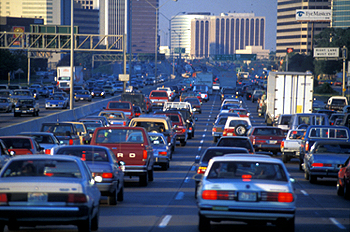Two things that aren’t mentioned in this story but need to be.
Two adjoining stretches of U.S. 59 in downtown and west Houston fared the worst regionally on an annual list of the 100-most congested freeways in the state, compiled by Texas Department of Transportation and Texas A&M Transportation Institute officials.
[David] Schrank, a co-author of the report, said changes to methodology led to some spikes in average congestion along certain routes. Areas with major freeway interchanges saw average congestion estimates increase, giving planners a fuller view of the gridlock afflicting most areas of the state.
The additional traffic is having a pronounced effect in certain areas, Schrank said: “These areas are teetering on really, really heavy congestion for long hours of the day.”
Houston’s two worst freeway segments are along U.S. 59. The stretch from Interstate 10 to Texas 288 ranks second-worst in the state, with an average of 743,006 hours of delay annually, per mile. The freeway from 288 to Loop 610 West ranks third-worst, with 730,655 hours of annual delay, per mile. Only a segment of Interstate 35 in downtown Austin fares worse.
Along both parts of U.S. 59, the new figures show a worsening pattern. Traffic on the eastern segment increased roughly 50 percent. Intense traffic at the interchanges with I-10 and Texas 288 was largely to blame, Schrank said.
“When you have a really, really bad quarter-mile or half-mile, it makes the whole area much worse,” he said.
Part of the problem is design and high demand for the freeway during many hours of the day, Harris County Judge Ed Emmett said.
“You clearly have as much traffic going north and eastbound on 59 in the afternoon as you do in the morning,” Emmett said, saying any remedy needs to consider the traffic flow.
That same problem causes backups on 288 northbound as well. Interchanges are a big part of the problem, no doubt. I-10 eastbound at I-45 South, where the one exit lane can be backed up to the Studemont exit or farther, is a classic example of this. But as I’ve noted before, the main issue with 59 northbound as you approach 288/45 is that it narrows down from five lanes to three at the downtown spur, then down to two lanes at the 288/45 turnoff. The volume of traffic that wants to continue north on 59 past these points is just too much for the available capacity. I hesitate to make absolute statements, but I don’t see how this can ever be resolved by adding more lane capacity, because there just isn’t the room for it. It’s a problem that isn’t going to go away.
The other point is that one big reason why there’s so much demand for that limited amount of lane space is because we’ve spent the past 20 years building much more lane capacity from Loop 610 and/or Beltway 8 outward on all the major freeways. A lot more people now live out where those expanded freeways take them, and they’re all trying to fit into those squeezed spaces on their way to and from their homes. That’s not the only reason for this – as noted, the traffic problem exists well outside the rush hours these days – but the same principle is in play. There’s much more demand for these freeways outside these urban core congestion zones, and that demand puts extra pressure on the places that are least able to handle it.
I’ve said this before and I’ll say it again: We’ve pretty much maxed out our ability to deal with traffic by throwing more lanes at it. Unless we start double-decking or building tunnels, what we’ve got most places is what we’re going to have. One thing we can do but have not done is provide viable alternatives to taking the freeways for the people who are mostly moving about in town. Taking the people who are making short trips out of the equation and you can free up some space for the long haul drivers who have no other alternative. It’s the same argument I make about urban core restaurants providing bike parking to help keep spaces available for the customers who have to drive to get there. That’s going to require a much bigger commitment to and investment in public transportation, and so far there isn’t much evidence that’s going to happen. If they really thought about it, the people who have to navigate these traffic disasters every day ought to be the biggest supporter of expanded mass transit precisely because it will help get the people who would have options other than driving off the road. Someday I hope that argument sinks in.


You’re right that it’s not just an ‘add some lanes’ solution to this problem.
However, if 45 in downtown was redesigned (w/ tunnel and acting as a downtown bypass) and the spur was extended and incorporated into this redesign (by tunneling) then you’d have some ways of reducing the major bottlenecks on 59. However, the major overhaul that is needed isn’t getting the holistic view that’s needed. Instead, TxDOT takes a limited, individual highway approach when a network approach is needed in this area.
Just look at their options: http://www.ih45northandmore.com/
It’s either ‘add more lanes’ or ‘add a single tunnel for HOT lanes’. None of which get at the bottleneck issues that occur when freeways intersect.
Addressing the 59 stretch to 288 can be piggy-backed onto an already in process project. However, the myopic tendencies of TxDOT doesn’t see that.
Time for a Texas-sized “big dig”. That’ll show those uppity Bostonians how to spend money on construction projects! And while we’re at it, let’s get rid of the Pierce Elevated section of I-45, too!